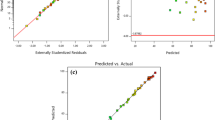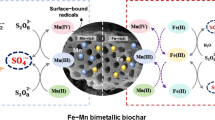Abstract
Biosorption is a technique widely used in the remediation of contaminated effluents, and its main advantages are its easy applicability, high efficiency rate, versatility, and its economic viability. Associated with nanotechnology, this work proposes the use of nanocomposites of sugarcane bagasse (SB) and ferromagnetic nanoparticles (Fe3O4) in the removal of metallic ions present in contaminated water. SB is a promising adsorbent material since it is an abundant agricultural residue, easily accessed. By using the coprecipitation method, two nanocomposites were obtained from in natura (SB-NP) or acid-treated (MSB-NP) sugarcane bagasse. These materials were synthetized by impregnation of Fe3O4 to gain paramagnetic properties and to facilitate the removal of the contaminant-containing adsorbent. The characterization of the nanocomposites was performed using pHPCZ, FTIR, XRD, and SEM/EDS techniques, to evaluate the synthesis efficiency and investigate the morphology of the materials. The efficiency of magnetite impregnation on the SB was assessed by SEM/EDS and XRD, while the main functional groups (carbonyl, carboxyl, hydroxyl, amine, amide, and nitrate) responsible for adsorption were found by FTIR. In the surface charge characterization by pHPCZ sorption of dyes, it was found that negative charges are predominant. The pHPCZ for SB-NP and MSB-NP was 5.95 and 5.59, respectively, and the chosen Cu(II) adsorption pH was 6.2 ± 0.1. The adsorption equilibrium was reached between 10 and 60 min of contact time. The maximum experimental sorption capacity (SCexp) was 2.53 ± 0.09 (SB-NP) and 2.61 ± 0.01 mg/g (MSB-NP). The isotherm models applied to the experimental data were Langmuir, Freundlich, Sips, Temkin, and Dubinin-Radushkevich, and Temkin best described the adsorption phenomena for Cu(II) by SB-NP (r2 = 0.9976 and χ2 = 3.965) and MSB-NP (r2 = 0.9990 and χ2 = 1.816). Reuse cycles of the nanocomposites were also performed employing ten cycles of sorption using 50 mg/L Cu(II) solutions, after which the materials showed SCexp = 7.47 ± 0.04 mg/g (SB-NP) and 7.82 ± 0.04 mg/g (MSB-NP). Therefore, the investigated materials exhibited promising results to be used as biosorbents in the remediation of effluents contaminated with toxic metal ions, such as copper.








Similar content being viewed by others
Data availability
Extra data are available from the authors (elma.carrilho@mail.com) upon reasonable request.
References
Abdolali A, Ngo HH, Guo W, Zhou JL, du B, Wei Q, Wang XC, Nguyen PD (2015) Characterization of a multi-metal binding biosorbent: chemical modification and desorption studies. Bioresour Technol 193:477–487
Amin NK (2008) Removal of reactive dye from aqueous solutions by adsorption onto activated carbons prepared from sugarcane bagasse pith. Desalination 223(1-3):152–161
Andrade Siqueira TC, Zanette SI, Rubio AJ, Bergamasco R, Gasparotto F, Paccola EADS, Yamaguchi NU (2020) Sugarcane bagasse as an efficient biosorbent for methylene blue removal: kinetics, isotherms and thermodynamics. Int J Environ Res Public Health 17(2):526
ATSDR (2002) Toxicological Profile for Copper (Draft for Public Comment), US Department of Health and Human Services, Public Health Service, Agency for Toxic Substances and Disease Registry (Subcontract N. ATSDR 205-1999-00024), Atlanta
Barbosa JA, Labuto G, Carrilho ENVM (2020) Magnetic nanomodified activated carbon: characterization and use for organic acids sorption in aqueous medium. Chem Eng Commun:1–14
Barros MASD, Arroyo PA, Silva EA (2013) General aspects of aqueous sorption process in fixed beds. Mass Transfer-Advances in Sustainable Energy and Environment Oriented Numerical Modeling InTech, Rijeka, 361-386
Brandão PC, Souza TC, Ferreira CA, Hori CE, Romanielo LL (2010) Removal of petroleum hydrocarbons from aqueous solution using sugarcane bagasse as adsorbent. J Hazard Mater 175(1-3):1106–1112
Carrilho ENVM, Labuto G, Kamogawa MY (2016) Destination of vinasse, a residue from alcohol industry: resource recovery and prevention of pollution. In: Prasad MNV (ed) Environmental Materials and Waste, 1st edn. Elsevier, Amsterdam, pp 21–43
Debs KB, Cardona DS, da Silva HD, Nassar NN, Carrilho EN, Haddad PS, Labuto G (2019) Oil spill cleanup employing magnetite nanoparticles and yeast-based magnetic bionanocomposite. J Environ Manage 230:405–412
Demirbas E, Dizge N, Sulak MT, Kobya M (2009) Adsorption kinetics and equilibrium of copper from aqueous solutions using hazelnut shell activated carbon. Chem Eng J 148(2-3):480–487
Escudero LB, Quintas PY, Wuilloud RG, Dotto GL (2019) Recent advances on elemental biosorption. Environ Chem Lett 17(1):409–427
Fideles RA, Ferreira GMD, Teodoro FS, Adarme OFH, da Silva LHM, Gil LF, Gurgel LVA (2018) Trimellitated sugarcane bagasse: a versatile adsorbent for removal of cationic dyes from aqueous solution. Part I: Batch adsorption in a monocomponent system. J Colloid Interface Sci 515:172–188
Fiol N, Villaescusa I (2009) Determination of sorbent point zero charge: usefulness in sorption studies. Environ Chem Lett 7(1):79–84
Fontana L, Albuquerque ALS, Brenner M, Bonotto DM, Sabaris TPP, Pires MAF, Cotrim MEB, Bicudo DC (2014) The eutrophication history of a tropical water supply reservoir in Brazil. J Paleolimnol 51(1):29–43
Freitas GR, Vieira MGA, da Silva MGC (2018) Batch and fixed bed biosorption of copper by acidified algae waste biomass. Ind Eng Chem Res 57(34):11767–11777
Gandhi MR, Kousalya GN, Viswanathan N, Meenakshi S (2011) Sorption behaviour of copper on chemically modified chitosan beads from aqueous solution. Carbohydr Polym 83(3):1082–1087
Hameed BH, El-Khaiary M (2008) Removal of basic dye from aqueous medium using a novel agricultural waste material: pumpkin seed hull. J Hazard Mater 155(3):601–609
Ho YS, Wase DAJ, Forster CF (1996) Kinetics study of competitive heavy metal adsorption by sphagnum moss peat. Environ Technol 17:71–77
Homagai PL, Ghimire KN, Inoue K (2010) Adsorption behavior of heavy metals onto chemically modified sugarcane bagasse. Bioresour Technol 101(6):2067–2069
José JC, Debs KB, Labuto G, Carrilho ENVM (2019) Synthesis, characterization, and application of yeast-based magnetic bionanocomposite for the removal of Cu (II) from water. Chem Eng Commun:1–11
Karnitz JO, Gurge LVA, De Melo JCP, Botaro VR, Melo TMS, de Freitas RP, Gil LF (2007) Adsorption of heavy metal ion from aqueous single metal solution by chemically modified sugarcane bagasse. Bioresour Technol 98(6):1291–1297
Kim SH, Choi PP (2017) Enhanced Congo red dye removal from aqueous solutions using iron nanoparticles: adsorption, kinetics, and equilibrium studies. Dalton Trans 46(44):15470–15479
Labuto G, Cardona DS, Debs KB, Imamura AR, Bezerra KCH, Carrilho ENVM, Ferreira PSH (2018) Low cost agroindustrial biomasses and ferromagnetic bionanocomposites to cleanup textile effluents. Desalin Water Treat 12:80–89
Labuto G, Carrilho ENVM (2016) Bioremediation in Brazil: scope and challenges to boost up the bioeconomy. In: Prasad MNV (ed) Bioremediation and bioeconomy, 1st edn. Elsevier, Amsterdam, pp 569–586
Labuto G, Trama B, Gueller GCDS, Guarnieri BDS, Silva FVD, Collazo R (2015) Metals uptake by live yeast and heat-modified yeast residue. Rev Ambiente Água 10(3):510–519
Leal PR, Moschini-Carlos V, López-Doval JC, Cintra JP, Yamamoto JK, Bitencourt MD, Santos RF, Abreu GC, Pompêo MLM (2018) Impact of copper sulfate application at an urban Brazilian reservoir: a geostatistical and ecotoxicological approach. Sci Total Environ 618:621–634
Mascolo M, Pei Y, Ring T (2013) Room temperature co-precipitation synthesis of magnetite nanoparticles in a large pH window with different bases. Materials 6(12):5549–5567
Milani PA, Debs KB, Labuto G, Carrilho ENVM (2018a) Agricultural solid waste for sorption of metal ions: part I—characterization and use of lettuce roots and sugarcane bagasse for Cu (II), Fe (II), Zn (II), and Mn (II) sorption from aqueous medium. Environ Sci Pollut Res 25(36):35895–35905
Milani PA, Consonni JL, Labuto G, Carrilho ENVM (2018b) Agricultural solid waste for sorption of metal ions, part II: competitive assessment in multielemental solution and lake water. Environ Sci Pollut Res 25(36):35906–35914
Mittal A, Naushad M, Sharma G, ALothman ZA, Wabaidur SM, Alam M (2016) Fabrication of MWCNTs/ThO2 nanocomposite and its adsorption behavior for the removal of Pb (II) metal from aqueous medium. Desalin Water Treat 57(46):21863–21869
Moghaddam L, Rencoret J, Maliger VR, Rackemann DW, Harrison MD, Gutiérrez A, del Río JC, Doherty WOS (2017) Structural characteristics of bagasse furfural residue and its lignin component. An NMR, Py-GC/MS, and FTIR study. ACS Sustain Chem Eng 5(6):4846–4855
Oliveira MRF, do Vale Abreu K, Romão ALE, Davi DMB, de Carvalho Magalhães CE, Carrilho ENVM, Alves CR (2020) Carnauba (Copernicia prunifera) palm tree biomass as adsorbent for Pb (II) and Cd (II) from water medium. Environ Sci Pollut Res:1–12
Panneerselvam P, Morad N, Tan KA (2011) Magnetic nanoparticle (Fe3O4) impregnated onto tea waste for the removal of nickel (II) from aqueous solution. J Hazard Mater 186(1):160–168
Sadeek SA, Negm NA, Hefni HH, Wahab MMA (2015) Metal adsorption by agricultural biosorbents: adsorption isotherm, kinetic and biosorbents chemical structures. Int J Biol Macromol 81:400–409
Salleh MAM, Mahmoud DK, Karim WAWA, Idris A (2011) Cationic and anionic dye adsorption by agricultural solid wastes: a comprehensive review. Desalination 280(1-3):1–13
Santos VC, De Souza JV, Tarley CR, Caetano J, Dragunski DC (2011) Copper ions adsorption from aqueous medium using the biosorbent sugarcane bagasse in natura and chemically modified. Water Air Soil Pollut 216(1-4):351–359
Sarker TC, Azam SMGG, El-Gawad AMA, Gaglione SA, Bonanomi G (2017) Sugarcane bagasse: a potential low-cost biosorbent for the removal of hazardous materials. Clean Techn Environ Policy 19(10):2343–2362
Sun S, Zeng H (2002) Size-controlled synthesis of magnetite nanoparticles. J Am Chem Soc 124(28):8204–8205
Teodosiu C, Gilca AF, Barjoveanu G, Fiore S (2018) Emerging pollutants removal through advanced drinking water treatment: a review on processes and environmental performances assessment. J Clean Prod 197:1210–1221
Ullah I, Nadeem R, Iqbal M, Manzoor Q (2013) Biosorption of chromium onto native and immobilized sugarcane bagasse waste biomass. Ecol Eng 60:99–107
Vargas IT, Fischer DA, Alsina MA, Pavissich JP, Pastén PA, Pizarro GE (2017) Copper corrosion and biocorrosion events in premise plumbing. Materials 10(9):1036
Wang N, Chen J, Wang J, Feng J, Yan W (2019) Removal of methylene blue by Polyaniline/TiO2 hydrate: adsorption kinetic, isotherm and mechanism studies. Powder Technol 347:93–102
World Health Organization (2004) Copper in drinking-water: background document for development of WHO Guidelines for Drinking Water Quality
Yargıç AŞ, Şahin RY, Özbay N, Önal E (2015) Assessment of toxic copper (II) biosorption from aqueous solution by chemically-treated tomato waste. J Clean Prod 88:152–159
Yu L, Hao G, Gu J, Zhou S, Zhang N, Jiang W (2015a) Fe3O4/PS magnetic nanoparticles: synthesis, characterization and their application as sorbents of oil from waste water. J Magn Magn Mater 394:14–21
Yu JX, Wang LY, Chi RA, Zhang YF, Xu ZG, Guo J (2015b) Adsorption of Pb2+, Cd2+, Cu2+, and Zn2+ from aqueous solution by modified sugarcane bagasse. Res Chem Intermed 41(3):1525–1541
Zhang Z, Moghaddam L, O’Hara IM, Doherty WO (2011) Congo Red adsorption by ball-milled sugarcane bagasse. Chem Eng J 178:122–128
Funding
This work was supported by Fundação de Amparo à Pesquisa do Estado de São Paulo (FAPESP) and Conselho Nacional de Desenvolvimento Científico e Tecnológico (CNPq) under Grants 2016/06271-4 and 128105/2017-8, respectively.
Author information
Authors and Affiliations
Contributions
EC and GL postulated and supervised the study. JTC, PAM, and EC planned the experiment. JTC obtained the data, and EC, GL, PAM, and JTC carried out the data analysis and interpretation. GL performed the adjustment of all experimental data to the isothermal models applied. JLC executed all copper analysis by FAAS. JTC prepared the first draft, and EC and GL thoroughly revised the manuscript. EC, GL, and JTC read and approved the final manuscript.
Corresponding author
Ethics declarations
Competing interests
The authors declare that they have no competing interests.
Ethical approval
Not applicable.
Consent to participate
Not applicable.
Consent to publish
Not applicable.
Additional information
Responsible Editor: Tito Roberto Cadaval Jr
Publisher’s note
Springer Nature remains neutral with regard to jurisdictional claims in published maps and institutional affiliations.
Rights and permissions
About this article
Cite this article
Carvalho, J.T.T., Milani, P.A., Consonni, J.L. et al. Nanomodified sugarcane bagasse biosorbent: synthesis, characterization, and application for Cu(II) removal from aqueous medium. Environ Sci Pollut Res 28, 24744–24755 (2021). https://doi.org/10.1007/s11356-020-11345-3
Received:
Accepted:
Published:
Issue Date:
DOI: https://doi.org/10.1007/s11356-020-11345-3




